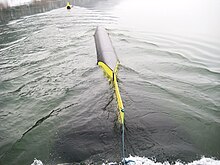Electricity buoy
Strom-Buje is the name of a floating flow power plant that converts the kinetic energy of a free-flowing, unblocked river into electrical energy . In its mode of operation, it is similar to a ship's mill or a towing generator . The concept was patented by Fritz Mondl and has since been further developed and marketed by Aqua-Libre GmbH.
Since the power buoy requires a minimum water depth of three meters and a flow speed of around two meters per second, it is suitable for use in Europe in medium to large Alpine runoffs such as the Danube , Inn, Rhine, Rhone, Po or Drau and Save. With relatively little intervention in the water, they can generate up to 100 kW of power around the clock.
properties
The current buoy is placed in the river in such a way that it floats slightly below the surface of the water at low to high mean water levels and is kept in the most favorable current by an anchor chain . The structural measures in the river consist of a drilled anchor rod and energy dissipation by means of submarine cables. Inside the buoy there is a turbine with two or three rotor blades, which is protected from floating debris, swimmers and boats by a self-cleaning flotsam rake. A diffuser is attached behind the rotor , which increases the usable cross section and consequently increases the flow on the rotor by generating a negative pressure. Several fish-ecological examinations prescribed by the Austrian Ministry of the Environment have shown that fish can pass the buoy without any additional structural facilities.
When the water level is high, the power buoy dips from the water surface so that large debris can swim over it.
According to the developers, this makes it currently the only flow hydropower plant that can withstand a major flood without damage and without blockages and that still supplies electricity in flood events even when classic run-of-river power plants have to be switched off. With a three times larger cross-sectional area at the rear end of the diffuser, a 250 cm turbine has an installed power of 100 kW. With an average flow speed of 2.0 m / s, this results in 250 MWh per year, which corresponds to an average output of approx. 30 kW . The length of the buoy is 11 m and the maximum width is 5.2 m with a mass of around 7 t . It should be designed for continuous operation with only 10 hours of maintenance per year and a service life of at least 175,000 hours (corresponds to 20 years of operation). All materials used - steel and PE are fully recyclable .
Obstructions to inland navigation are to be prevented by placing the current buoys outside the marked shipping channel.
commitment
Since 2015 there have been plans to make the Wachau in Austria - approx. 25 km of river and around 50,000 residents energy self-sufficient, the electricity supplier EVN has received the approval of a first power buoy park, the extensive official requirements for multi-year monitoring for fish ecology and river morphology caused delays in funding the project.
In the Danube near Kienstock there is a test facility in which, according to the manufacturer, four different prototypes have already been used for around nine years.
Furthermore, a trial operation on the Rhine near St. Goar is currently (2019) being undertaken.
Awards
In 2010 the project received the Austrian Climate Protection Award in the category Everyday Life & Ideas and the Austrian Energy Globe Award . At the presentation of the Energy Globe Awards, it was particularly emphasized that the power buoy can be used with minimal interference with the environment. By Governor Pröll , Austrian milestone award was presented, 2015.
Web links
- Aqua Libre GmbH
- Potential for micro hydropower plants in Northern Germany using the example of the ship mill and the power buoy , FH Flensburg
Individual evidence
- ↑ Patent No. WO2005078276A1 from August 25, 2005
- ^ Patent " Einlaufschaufeln " , on: European Patent Office, accessed on December 29, 2019
- ↑ Detlef Stoller: Small floating power plants conquer Danube and Rhine , on: ingenieur.de from August 20, 2014, accessed on August 25, 2014.
- ↑ Potential for micro hydropower plants in northern Germany using the example of the ship mill and the power buoy . Flensburg University of Applied Sciences . Retrieved December 2, 2013, p. 18.
- ↑ EVN future projects accessed on December 29, 2019
- ↑ " Floating swarm of electricity buoys - mini power plants in the Rhine " on Heise.de from May 19, 2019, accessed on December 29, 2019
- ↑ Austrian Climate Protection Prize 2010: The winners have been selected. Broadcast on November 9, 2010, accessed on December 22, 2010.
- ↑ Energy Globe for river buoy with generator , NÖN from November 29, 2010, accessed on December 22, 2010.
- ↑ Project description of the Energy Globe Award ( memento of the original from December 12, 2013 in the Internet Archive ) Info: The archive link was automatically inserted and not yet checked. Please check the original and archive link according to the instructions and then remove this notice.

